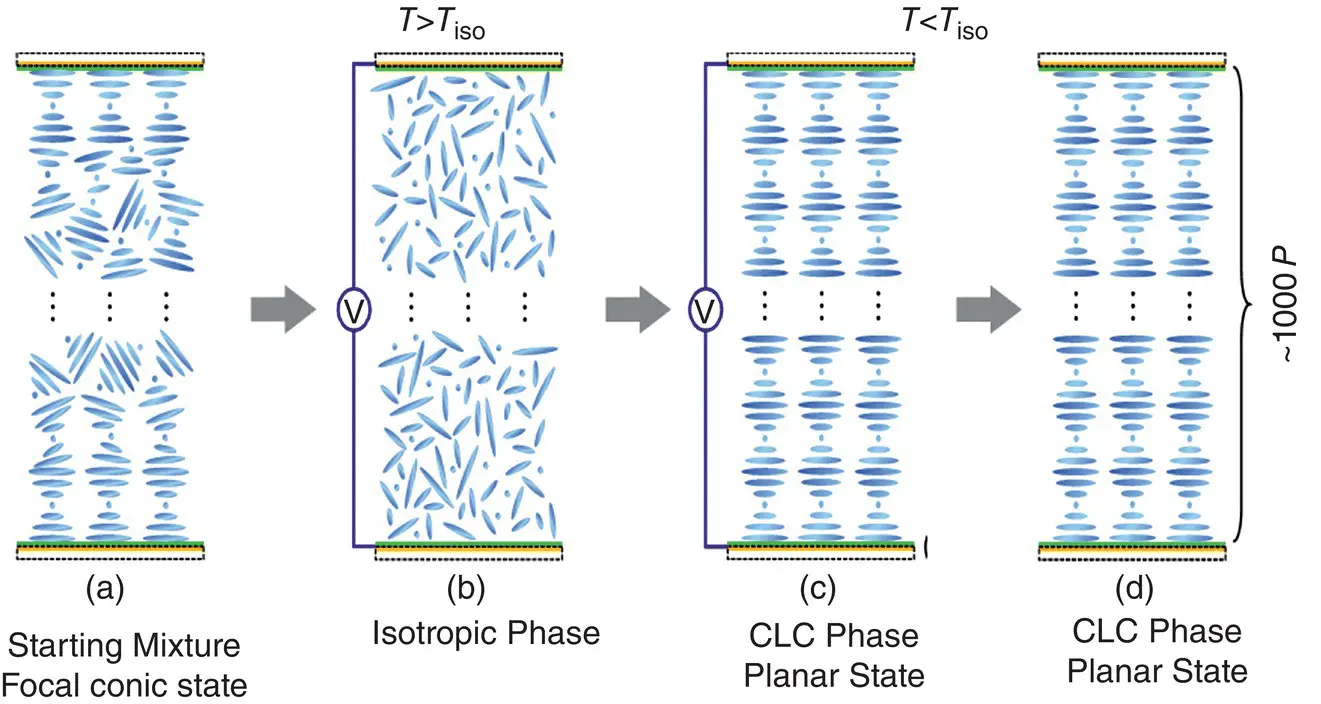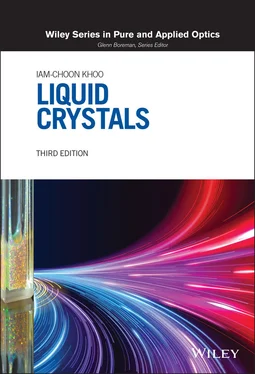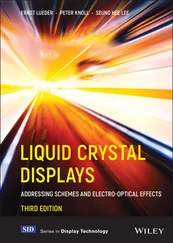Iam-Choon Khoo - Liquid Crystals
Здесь есть возможность читать онлайн «Iam-Choon Khoo - Liquid Crystals» — ознакомительный отрывок электронной книги совершенно бесплатно, а после прочтения отрывка купить полную версию. В некоторых случаях можно слушать аудио, скачать через торрент в формате fb2 и присутствует краткое содержание. Жанр: unrecognised, на английском языке. Описание произведения, (предисловие) а так же отзывы посетителей доступны на портале библиотеки ЛибКат.
- Название:Liquid Crystals
- Автор:
- Жанр:
- Год:неизвестен
- ISBN:нет данных
- Рейтинг книги:4 / 5. Голосов: 1
-
Избранное:Добавить в избранное
- Отзывы:
-
Ваша оценка:
- 80
- 1
- 2
- 3
- 4
- 5
Liquid Crystals: краткое содержание, описание и аннотация
Предлагаем к чтению аннотацию, описание, краткое содержание или предисловие (зависит от того, что написал сам автор книги «Liquid Crystals»). Если вы не нашли необходимую информацию о книге — напишите в комментариях, мы постараемся отыскать её.
Liquid Crystals,
Liquid Crystals
Liquid Crystals
Liquid Crystals — читать онлайн ознакомительный отрывок
Ниже представлен текст книги, разбитый по страницам. Система сохранения места последней прочитанной страницы, позволяет с удобством читать онлайн бесплатно книгу «Liquid Crystals», без необходимости каждый раз заново искать на чём Вы остановились. Поставьте закладку, и сможете в любой момент перейти на страницу, на которой закончили чтение.
Интервал:
Закладка:
Besides these two standard cell alignments, there are many other variations such as hybrid, twisted, supertwisted, and fingerprint; multi‐domain vertically aligned; and so on. In recent years [17, 27], photo‐alignment of dye‐doped cell window surface has also been shown to be highly effective for imparting the desired liquid crystal director axis arrangement.
For smectic‐A, the preparation method is similar to that for a homeotropic nematic cell. In this case, however, it helps to have an externally applied field to help maintain the homeotropic alignment as the sample (slowly) cools down from the nematic to the smectic phase. The cell preparation methods for surfaced‐stabilized FLC (SSFLC) operation is more complicated as it involves surface stabilization [28, 29]. On the other hand, Sm‐A *cells for soft‐mode (SM‐FLC) operation are easier to prepare using the above methods [30].
1.5.2. Cholesteric Liquid Crystal Cell Assembly
Cholesteric liquid crystals occupy a special niche in fundamental studies as well as optical applications owing to their photonic crystal properties. They are prepared in a similar fashion to the planar nematic sample, except that a small amount of chiral dopant is added to the starting nematic material [31]. Owing to the strong anchoring condition on the two cell windows, and the rotation ability of the chiral agent, the director axis of the CLC evolves as a spiral helix from one cell wall to the other, cf. Figure 1.11. In general, such helical arrangement of the director axis can be maintained by cell surfaces’ anchoring for sample thicknesses up to tens of microns; thicker cells invariably exhibit highly scattering focal conic texture associated with the helical axis becoming randomly oriented in bulk, cf. Figure 1.20a.
Recent studies [31–33] have shown that the so‐called field assisted self‐assembly (FASA) technique could produce very stable and well‐aligned CLC cells with thicknesses approaching 1 mm, with a period number N as large as 3000. The technique works by using nematic liquid crystals with negative dielectric anisotropy and a strong AC field during the sample preparation stage to enforce the required planar alignment of the LC molecules and therefore prevent the director axis rotation helix from deviation into a focal conic structure, as illustrated in Figure 1.20b and c. The empty cell is first filled with CLC mixture in the isotropic phase (see Figure 1.20b); then, as the sample is allowed to cool down slowly to room temperature, an AC electric (~2500 V; 1 kHz) is applied across the cell window for an extended period while the mixture sits at room temperature ( Figure 1.20c and d).

Figure 1.20. (a) CLC with focal conic structure as a result of director axis deviating from planar alignment. (b) Random orientation of director axis in the isotropic liquid phase; AC voltage on. (c) Sample cooling down to ordered phase; strong AC field enforces planar alignment. (d) AC field removed after an extended period.

Figure 1.21. Left: Image of logo obstructed by a thin CLC cell with focal conic alignment. Right: Clear image viewed through a well‐aligned sample following the FASA treatment.
The fabricated cells are found to exhibit uniform planar alignment with low scattering loss, cf. Figure 1.21, and well‐defined photonic bandgaps with long‐ and short‐wavelength band‐edges that can be tailored to fit any wavelength in the visible to near‐rIR spectrum (400–2000 nm). The dispersion and other chiral photonic properties of these extraordinarily thick CLC’s have enabled advanced photonic processes such as ultrafast modulation of femtosecond laser pulses and polarization rotation/switching that are impossible with their conventional thin counterparts [31–33].
1.5.3. Blue‐phase Liquid Crystal Cell Assembly
Cholesteric blue phase liquid crystals, commonly called blue‐phase liquid crystals (BPLC) [25, 31,34–39], are a special class of LC that may be regarded as the 3‐D variant of CLC. When first discovered, they existed only in a very narrow temperature range (<1 °C), but following the work by several groups, room temperature BPLCs with moderate to large temperature range became available in recent years; room temperature pristine BPLC [34] with a sizeable blue‐phase range (~9 °C) can now be routinely synthesized using a mixture that contains a chiral dopant S‐811 (Merck) and two nematic hosts (E48 and 5CB) in the ratio: S811 (36%):E48 (32%):5CB (32%). Owing to the increased concentration of the chiral agent in the BPLC, the molecules self‐assembled into tightly wound double‐twist cylinders, cf., instead of a simple helical arrangement as in CLC. The disclination lines among the cylinders form a network that exhibits cubic crystalline structures, cf. Figure 1.22.
In order to extend the working temperature range, a standard practice is polymer stabilization of the BPLC lattice [34–38]. Polymer‐stabilized blue‐phase liquid crystals (PS‐BPLC) are obtained by blending the chiral nematic material used to synthesize BPLC with photocurable prepolymers and polymerize the blend with UV or visible light depending on the type of photocurable prepolymer used. Typical phase sequence of the resulting PS‐BPLC in [34] is: Iso‐(56.2 °C)‐BP‐(<0 °C)‐N, i.e. the temperature range is ~56 °C.
As a function of the temperature, pristine BPLC with the constituents described in [34] typically exhibits the following phase sequence: transparent isotropic liquid phase for T > 31 °C; bluish color BPII phase (at T ~ 31–28 °C); greenish color BPI (at T ~ 28–23 °C), and cholesteric focal conic phase N *(below 23 °C). The BPLC temperature range is ~8 °C. The defect (disclination) lines are discontinuous in BPI phase but form a continuous network in BPII phase with body‐centered cubic (BCC) or simple cubic symmetries depicted in Figure 1.22. The lattice constants (dimension of these unit cells) are on the order of optical wavelength, and thus BPLCs typically exhibit photonic crystalline properties such as bandgaps and selective reflections in the blue‐green region [34–39] but are otherwise optically isotropic at a wavelength outside the bandgap. In [38], it is shown that with the so‐called RAF (repetitively applied field) technique, one could reconfigure the network into other non‐cubic crystalline symmetries.
In general, specific alignment on the cell windows is not needed for preparing BPLC sample, owing to the random orientations of the director axis of the defect lines or double‐twist cylinders on the boundary surfaces. In most studies, the cell windows are coated with an alignment layer to impart specific crystalline plane orientations.
Unlike nematic or CLCs where the entire sample behaves as a single crystal, BPLC and PS‐BPLC samples prepared with the aforementioned procedures are invariably in the polycrystalline or nearly amorphous state with a grainy appearance. Recent studies have shown that single‐crystal BPLC that is extraordinarily large in all three dimensions – up to 10 000s of unit cells (cm) wide and 100s of unit cells (>100 μm) thick can be grown with a special gradient‐temperature scanning (GTS) technique [38]. These single crystals exhibit sharp photonic bandgaps, long‐range periodicity in all dimensions, and well‐defined lattice orientation, cf. Figure 1.23. The study has also demonstrated the possibility of polymer stabilization that enables not only a much wider operating BP temperature range but also exceptional electrical tunability of the spectral properties. More details on the optical properties of CLC and BPLC as 1‐ and 3‐D photonic crystals are given in Chapter 4.
Читать дальшеИнтервал:
Закладка:
Похожие книги на «Liquid Crystals»
Представляем Вашему вниманию похожие книги на «Liquid Crystals» списком для выбора. Мы отобрали схожую по названию и смыслу литературу в надежде предоставить читателям больше вариантов отыскать новые, интересные, ещё непрочитанные произведения.
Обсуждение, отзывы о книге «Liquid Crystals» и просто собственные мнения читателей. Оставьте ваши комментарии, напишите, что Вы думаете о произведении, его смысле или главных героях. Укажите что конкретно понравилось, а что нет, и почему Вы так считаете.












